

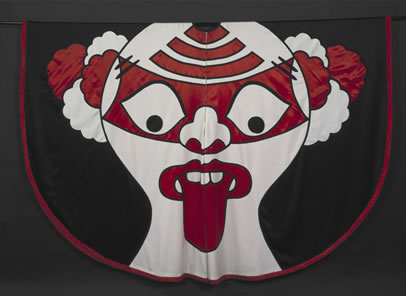
1971年 (昭和46) 、日本人として初めてロンドンでファッションショー "KANSAI IN LONDON" を開催した山本寛斎。作品の斬新なデザイン、歌舞伎から影響を受けた大胆なショーの演出、その全てにおいて拍手喝采を浴び、一躍世界のファッション界へとその名を轟 (とどろ) かせた。このマントは、 "KANSAI IN LONDON" で発表され、そのポップなエネルギーはロンドン中のファッション・ピープルから注目を集めた。
秋田県に伝わるベラボー凧の図案を山本寛斎流にアレンジ。プリントではなく、図柄をパッチワークでつなぎ、前開きジッパーで着用できるようになっている。
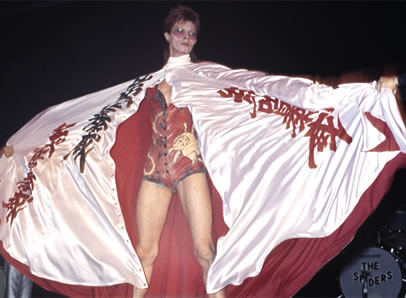
日本の神話に登場する因幡の素兎を図案に採用。1971年 (昭和46) 、山本寛斎が日本人として初めてロンドンで開催したファッションショー、 "KANSAI IN LONDON" で発表された作品。その後、1973年デヴィッド・ボウイ初めてのワールドツアー「ジギー・スターダスト」、「アラディン・セイン」両ツアーでステージ衣装として使用された。 1970年代初め、古い時代の着物の柄に注目し、それに関する資料や書籍を熱心に研究していた山本寛斎。髑髏 (どくろ) や蛇の目傘、とんぼの姿まで着物の図柄に取り入れてしまう日本人のポップな感性に感銘を受けた作品。
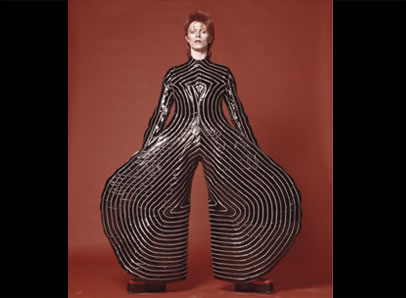
ロンドンのショーで大喝采を浴びた山本寛斎のもとに、ある依頼が届く。「デヴィッド・ボウイのステージ衣装を作って欲しい。」すでにイギリスでは人気を博していたデヴィッド・ボウイ、彼にとっては初めてとなるアメリカでのコンサート、そしてワールドツアー「ジギー・スターダスト」、「アラディン・セイン」両ツアーのためのステージ衣装を山本寛斎に手掛けて欲しいという依頼である。 歌舞伎の「引抜き」を応用した仕掛けが服には施してあり、コンサートでは一瞬にして下に着ている衣装 (ショルダーネックのニット) が現れた。
「ニューヨークのラジオシティミュージックホールでこの衣装を着たデヴィッド・ボウイの音楽の世界は、生涯私の脳に強い残像として刻み込まれています。」 (山本寛斎)
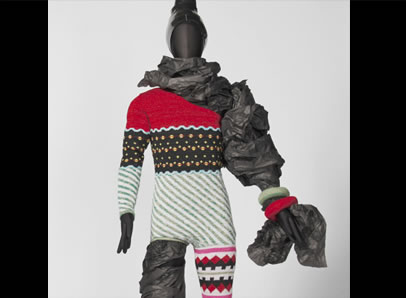
1973年 (昭和48) 、デヴィッド・ボウイ初めてのワールドツアー「ジギー・スターダスト」、「アラディン・セイン」両ツアーのためにデザインされたステージ衣装。 「着物の最大の特徴は、柄の重ねにある。」と分析した寛斎は、それをニットで表現しようと試みている。さらに形をアシンメトリー (ワンショルダー) にしたことにより、寛斎独自のデザインが誕生した。ブレスレットとアンクレットもニットで制作し、全体的に絶妙なバランスを取っている。 当時、山本寛斎ブランドの刺繍とニットは、世界のファッション界で群を抜いていた。「常時、尋常ではない数の色糸がアトリエに揃っていました。」と山本寛斎は語る。権威あるファッション誌 "ELLE" フランス版の裏表紙には寛斎ブランドのニットの作り方が連載されていた。
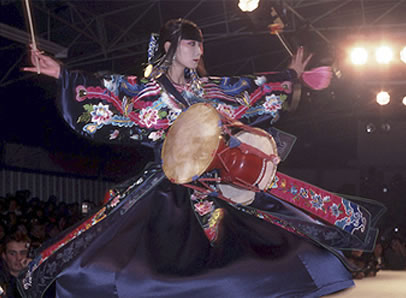
1983年春夏パリコレクション発表作品、山口小夜子着用。
デザイナーとして「刺繍」に熱いエネルギーを感じていた山本寛斎。中国昆明地方に住む山岳民族の民族衣装から触発された作品である。実物は、藍染の布に刺繍を施したものだが、それを寛斎流に大胆に表現したものがこのツーピース。モチーフに伝説の鳥、不死鳥が用いられている。
寛斎が世界最高峰の技術と絶賛する横振り刺繍 (群馬県桐生市の伝統産業) に注目して欲しい。
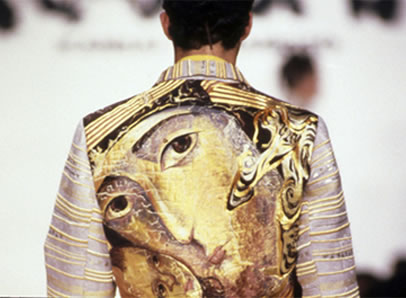
1990年-1991年秋冬パリコレクションで発表された作品。
ロシア正教、イコンをモチーフに繊細な金糸、銀糸の刺繍を背中全面に施したジャケット。群馬県桐生市、日本有数の横振刺繍ミシンの技が最大限に生かされている。
山本寛斎本人がタキシードジャケットとして着用していた。
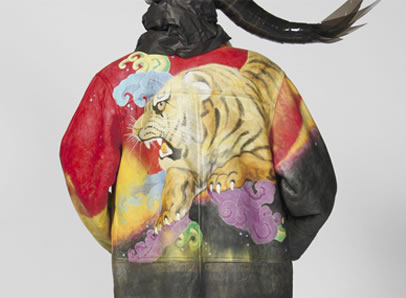
虎、波、ボカシをムートンコート全面に手描きしている。
前中心は古着感覚を表現するためにわざと切り落としている。
虎と龍は、山本寛斎が好んで表現し続けているモチーフ。

2004年 (平成16) 、日本武道館で開催されたスーパーショー「アボルダージュ ~接舷攻撃 (せつげんこうげき) ~」のために制作された着物群。「アボルダージュ ~接舷攻撃~」は、命をかけて自分の信念を貫いた新撰組、土方歳三に深く共鳴した山本寛斎が、構想30年の歳月をかけて実現したスーパーショーである。
現代では出せない着物の色、草木染の美しさに心惹かれた山本寛斎。「アボルダージュ」衣装のために、日本中から大正時代と昭和初期の着物を集めた。しかし、当時の女性は現代より小柄な体型だったため、出演する女優陣に着せようとしても着丈や袖丈が短い。そこで、柄も色も違う着物2着から3着を、全てほどき、新たに組み合わせて縫うことで1着を完成させた。決して常識にとらわれない山本寛斎の、豊かな想像力の結晶がこの着物にもあふれている。
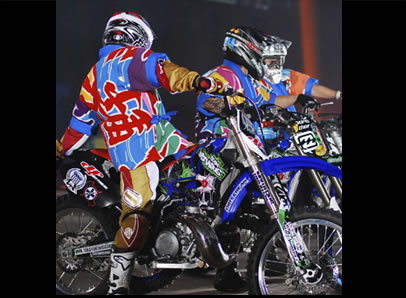
日本の神話に登場する因幡の素兎を図案に採用。1971年 (昭和46) 、山本寛斎が日本人として初めてロンドンで開催したファッションショー、 "KANSAI IN LONDON" で発表された作品。その後、1973年デヴィッド・ボウイ初めてのワールドツアー「ジギー・スターダスト」、「アラディン・セイン」両ツアーでステージ衣装として使用された。 1970年代初め、古い時代の着物の柄に注目し、それに関する資料や書籍を熱心に研究していた山本寛斎。髑髏 (どくろ) や蛇の目傘、とんぼの姿まで着物の図柄に取り入れてしまう日本人のポップな感性に感銘を受けた作品。
ライダースーツ提供:佐藤英俉氏
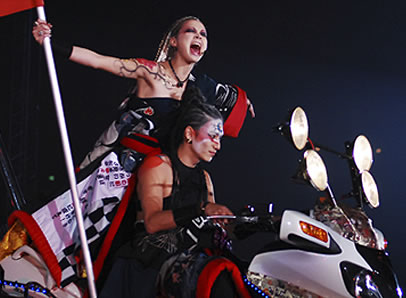
万祝 (まいわい)、江戸時代に生まれた筒描染め古布、さらに長渕剛氏がスーパーショーのために書き下ろしたテーマ・ソング「太陽の船」の歌詞、この3つをコラージュした山本寛斎オリジナルの祭り衣装。
「『万祝』は、大漁の際、船主が乗り手たちにお祝いとして配った『漁師の晴れ着』のことで、その鮮やかな半纏衣裳は、世界にも類をみないわが国の漁民芸術の粋である。藍色の地に極彩色の鶴亀や宝船・鯛・高砂・三人囃子などバラエティに富み、めでたい図柄を鮮やかに染めあげた万祝姿は、漁村の風物詩であった。」 (仁科又亮監修『万祝』、岩崎美術社刊より引用)
「祭りは、日本人が最も光り輝く瞬間ではないでしょうか?私は日本中のお祭りを見てきましたが、祭りの夜、女性は最高に色艶やかに、男性は最も勇ましく熱と輝きを放っていると自信を持って断言できます。私は、日本人の持つ元気、そして強烈なエネルギーをスーパーショーという世界最大の祭りの中で表現していきたいと決意しているのです。」 (山本寛斎)
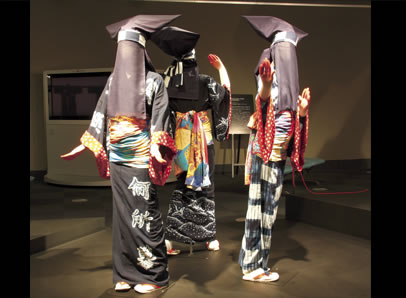
愛知県名古屋市有松(ありまつ)に伝わる伝統の絞り染めが有松絞り。尾張藩が有松絞りを藩の特産品として保護し、竹田庄九郎を御用商人に取り立てて以来、400年の歴史を誇る。
【漢詩文藍絞浴衣 (かんしもんあいしぼりゆかた) 】
600年代の中国の宰相の詩。折縫い絞を本藍染で制作。
【波に飛鶴文藍絞浴衣 (なみにひかくもんあいしぼりゆかた) 】
鹿の子絞とししげ縫い絞を本藍染で制作。
【段変わり縞文藍絞浴衣 (だんがわりしまもんあいしぼりゆかた) 】
有松絞りの開祖竹田庄九郎考案の手筋鎧段絞 (てすじよろいだんしぼり) を本藍染で制作。
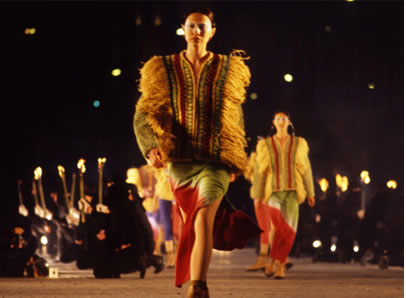
1993年 (平成4) 、「HELLO! RUSSIA (ハロー!ロシア) 」のために制作されたジャケット。東北地方の農作業で昔から使われていた背負子から触発されたデザイン。日本海沿岸に伝わる古くなった着物を裂いて使うリサイクル技術・裂織 (さきおり) でシルクの糸と布を編みこんだジャケットに仕立てている。



"KANSAI IN LONDON" in 1971 was the first fashion show in London by a Japanese designer. The daring designs, the audacious show direction inspired by Kabuki theatrical technique, every aspect of the show won frantic acclaim, pushing Kansai Yamamoto to the forefront of world fashion scene.
The jumpsuits,"Kite", from "KANSAI IN LONDON", allured a broad range of fashion people throughout London with its pop energy. Kansai rearranged typical design of traditional "belabo" kites from Akita Prefecture, patch-working the design patterns together into a jumpsuits, to be worn with front zipper.

The design was inspired by the Japanese ancient legend, "Inaba no Shiro Usagi ". This jumpsuit was introduced in the 1971 "KANSAI IN LONDON ", the first fashion show in London by a Japanese designer. The piece was then worn in 1973 as stage costume by David Bowie during his first world tours, "Ziggy Stardust " and "Aladdin Sane ".

Following the raving acclaim for his first show in London, Kansai is approached by David Bowie, through a mutual friend, to create his costume for the prospective stages.
Already an icon in England, Bowie was about to launch his first concert in the U.S. and the world tours, "Ziggy Stardust " and "Aladdin Sane ". The jumpsuit incorporates a Kabuki "hikinuki " (pull-off) technique. In the concert, a shoulder-neck knitted costume that Bowie wore underneath appeared in just a split second.
"The image of David in this costume and the whole musical universe he created in Radio City Music Hall, New York, has been chiseled in my brain with unfading vividness ". - Kansai Yamamoto

The costume was created for David Bowie's first world tours, "Ziggy Star Dust " and "Aladdin Sane ". Kansai analyzed the most characteristic feature of kimono as "the way different design patterns are layered on top of each other ", which he tried to recreate in a knitted realm. Furthermore, Kansai gave birth to this radical piece with a one-shoulder asymmetrical form. A delicate total balance is achieved with an ensemble of a knitted bracelet and an anklet.
At the time, embroidery and knitted pieces of Kansai Yamamoto brand reigned brilliantly in the world fashion scene. The magazine, ELLE France, featured a series showing how to create Kansai brand knitted pieces.
Kansai recalls, "We were regularly equipped with a monstrous variety and volume of knitting threads in our atelier ".

The two piece work was introduced in Kansai's 1983 Spring-Summer Collection in Paris, worn on stage by Sayoko Yamaguchi.
As a fashion designer, Kansai had always been intrigued by an explosive energy in the medium, embroidery. This two piece work was inspired by traditional costumes of the hill tribe people in the Kung Ming region of China.
Please note the "Kiryu yoko-buri " embroidery technique (traditional craft in Kiryu City, Gunma Prefecture) used in this work, which Kansai praises as one of the most amazing techniques in the world.

Introduced in Kansai's 1990-1991 Autumn-Winter Collection in Paris.
The whole back of the jacket features an intricate embroidery of gold and silver threads with a motif of Icon from the Russian Orthodox Church. Again, Kansai has made the most of the traditional "Kiryu yoko-buri " embroidery technique from Kiryu City, Gunma Prefecture.

Tiger, wave, and the gradation patterns are hand drawn over the whole coat.
Tigers and dragons remain Kansai's favorite motifs.

The group of kimonos was produced for the super show, "Abordage ", staged at Nippon Budokan in 2004. The spectacle show was realized after 30 years of planning, overlapping Kansai's own life with the unyielding spirit of Toshizo Hijikata, the vice captain of Shinsengumi, the special forces to the last Shogun.
Enchanted by the sublime beauty of the antique kimono colors derived from plant dye, and seeing that the depth of nuance cannot be created with present–day technique, Kansai searched all over Japan for kimonos from the Taisho period (1912–26) and the early years of the Showa period (1926–89) for the "Abordage " costume material. Since the women in those days were much smaller than contemporary Japanese women, the collected pieces generally lacked sleeve and general length on the super-show cast. Two to three pieces of different color and design scheme were taken apart, then put together as one under a new design. Again, the creation is a revelation of Kansai's unbound imagination.

The hanten jacket was produced for the super show, "Taiyo no Fune " (the sun vessel) that Kansai produced and directed in 2007, drawing an audience of 42,000 and critical acclaim at Tokyo Dome. Traditionally, banners to indicate a good catch of fish are regular item for celebratory events in fishing villages. Noting the vivid colors, daring designs and patters on those banners, Kansai created padded Hanten jackets out of them. In the super show, six free-style motocross riders clad in those jackets danced at Tokyo Dome in mid-air with grace and breath taking dynamism.

The festival costume originally designed by Kansai Yamamoto is a collage of three contentss; the antique fabric created through tsutsugakizome (hand dye using tube device) , and the lyrics from the theme song, "Taiyo no Fune " specially created by Tsuyoshi Nagabuchi, and "Maiwai ".
"Maiwai are the banten jackets traditionally given out by ship owners to fishermen at the time of good catch, in other words, "Fishermen's gala attire ". The colorful costume is truly the epitome of Japanese fishery art and culture, unique and unparalleled throughout the world. A variety of designs range from the standard tortoise & crane, treasure vessel, happy old Takasago couple, to a trio of musicians, the vividly dyed celebratory patterns were typical items in fishing villages ". quoted from "Maiwai ", published by Iwasaki Bijutsu Sha.
"Matsuri (festival) seems to possess precious moments when Japanese people shine their best. After studying festivals throughout Japan, I am convinced that it is on those Matsuri nights, women glow with special sensuality, and the men beam with awesome energy. And I am determined to express the vital spirit and the strong energy of Japanese people in my super shows, which are festivals taken to maximum scales. " -Kansai Yamamoto

Arimatsu tie dye is the traditional dye style passed on in Arimatsu region of Nagoya city, Aichi Prefecture. Arimatsu tie dye boasts a long history of 400 years ever since the Owari Han, the feudal domain of Japan in the Edo period (1603-1868) , protected it as Han's official specialty products and appointed Shokuro Takeda as Han's contractor.

The jacket was produced in 1993 for Kansai's super show, "HELLO! RUSSIA ". The design was inspired by "Shoiko ", the wooden frame back pack traditionally used among farmers in northern Japan. Kansai wove silk threads and fabrics into the jacket, using "Sakiori ", a technique passed on along the Japan Sea coastal region that rips and reuses old kimono material.